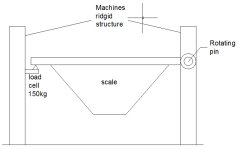grnick50
Lifetime Supporting Member
Dear all,
I am upgrading the control system of an old asphalt plant and I am phasing the following issue.
Two of its scales do not have 3 or 4 load cells at each corner of the scale as usual but it uses a lever principle instead.
From one side of the scale there is a pin welded to the frame of the machine. The other side of the scale is resting on a "knife" shaped beam that is attached to a 150kg beam type load cell.
The maximum weight that ever goes to the scale is 1500kg.
The problem is that there is no way to find out what is the maximum of the scale. In other words what coresponds to the 150kg. There is no drawings of the geometry of the scale to calculate the leverage, nor there is a way to get info from the current obsolete control system.
The new weight transmitter that goes in has the option to apply a known weight on the scale and then enter that value to the transmitter and let it do the maths.
I am wondering if anyone has experience from a similar case and if there is a better solution as I am afraid of non - linearities. Also, to do the calibrattion as mentioned above, requires a large amount of approved weight samples and that is sort of an issue.
Regards
I am upgrading the control system of an old asphalt plant and I am phasing the following issue.
Two of its scales do not have 3 or 4 load cells at each corner of the scale as usual but it uses a lever principle instead.
From one side of the scale there is a pin welded to the frame of the machine. The other side of the scale is resting on a "knife" shaped beam that is attached to a 150kg beam type load cell.
The maximum weight that ever goes to the scale is 1500kg.
The problem is that there is no way to find out what is the maximum of the scale. In other words what coresponds to the 150kg. There is no drawings of the geometry of the scale to calculate the leverage, nor there is a way to get info from the current obsolete control system.
The new weight transmitter that goes in has the option to apply a known weight on the scale and then enter that value to the transmitter and let it do the maths.
I am wondering if anyone has experience from a similar case and if there is a better solution as I am afraid of non - linearities. Also, to do the calibrattion as mentioned above, requires a large amount of approved weight samples and that is sort of an issue.
Regards








